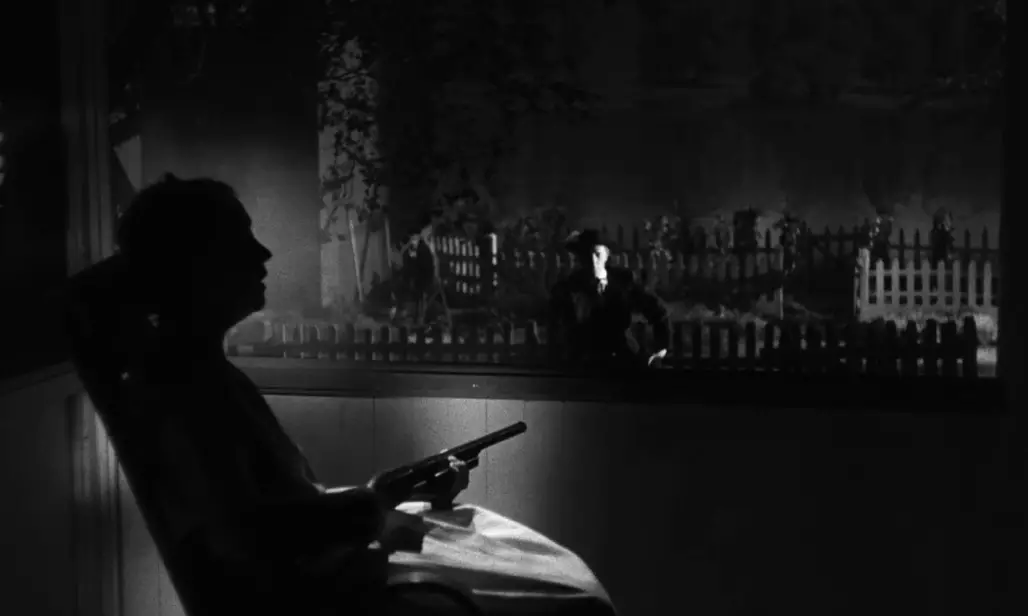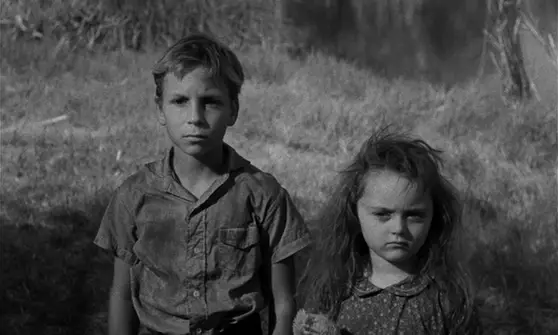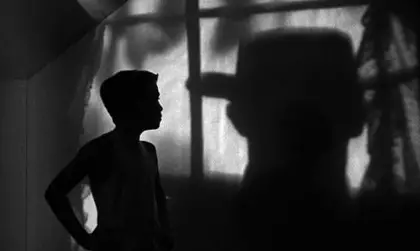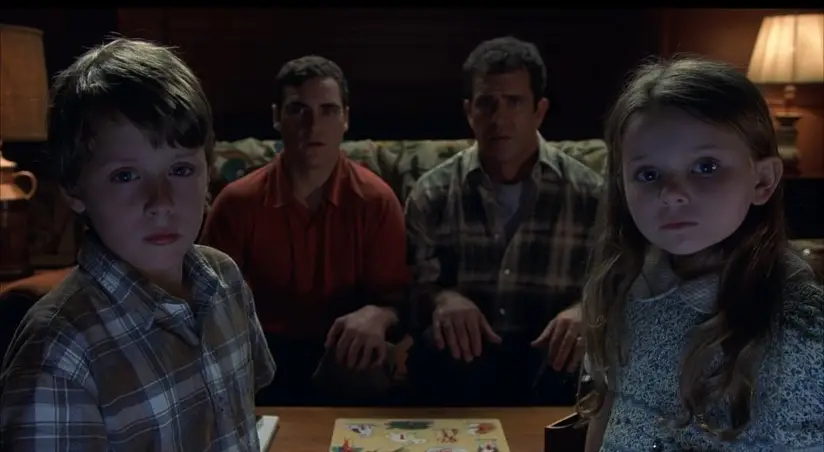
Director: Charles Laughton
Producer: Paul Gregory (United Artists)
Writers: Davis Grubb (novel), James Agee and Charles Laughton (screenplay)
Photography: Stanley Cortez
Music: Walter Schumann
Cast: Robert Mitchum, Shelly Winters, Lillian Gish, Billy Chapin, Sally Jane Bruce, James Gleason, Evelyn Varden, Peter Graves, Don Beddoe, Gloria Castillo
![]()
Introduction
Allow me to introduce a term I like to call “the disclaimer film,” invented to classify the type of film where you need to give modern audiences a disclaimer before they watch it. To a certain extent, many classic films require some bit of a setup, but this is particularly so with The Night of the Hunter. For despite its critical acclaim — a 98% on Rotten Tomatoes and No. 34 on the AFI’s 100 Thrills — young viewers laughed it off the screen during a college film course of mine, particularly at Robert Mitchum’s animated howl after a gunshot by Lillian Gish. “Dated” and “corny” was their reaction, but there’s a difference between actual datedness and an intentionally stylized approach from the start.
It was the vision of one-time-only director Charles Laughton, the legendary actor who had already won an Oscar in The Private Life of Henry VIII (1933), earned another nomination as Captain Bligh in Mutiny on the Bounty (1935) and played history’s best Quasimodo in The Hunchback of Notre Dame (1939). When it came time to make his directorial debut, he proposed “a nightmarish sort of Mother Goose tale.” (A) Laughton wanted his film to appear exaggerated, over-the-top and incredibly dreamlike, as if a story told through the eyes of children. Thus, the film remains more a fable than it is a traditional work of realism, a visual allegory for good and evil, and a world where, as the haunting opening song suggests, “Fear is only a dream. So dream, little one, dream.”
![]()
Plot Summary
Following a script by James Agree, The Night of the Hunter follows nine-year-old John Harper (Billy Chapin) and his four-year-old sister Pearl (Sally Jane Bruce), who are left fatherless when their Depression-weary pop, Ben (Peter Graves), robs a bank and kills two men in the process. With cops right on his heels, he runs home and delivers the stolen $10,000 to his two children, stashing it away in a secret hiding place known only to the three of them. In prison, Mr. Harper shares a cell with the Reverend Harry Powell (Robert Mitchum), a self-proclaimed “Man of God” with a hidden serial killer core, in jail on a stolen car rap. Just before Harper’s execution, Powell learns of the stolen money, and upon his own release, moves in on Harper’s family in search of the cash.
It’s there that he woos Ben’s recently-widowed wife, Willa Harper (Shelley Winters), who views him as a moral father-figure to her kids. Young Pearl instantly takes to Powell, even coming to call him “daddy,” but John refuses to accept him, saying, “You ain’t my dad! You’ll never be my dad!” The boy suspects Powell’s evil intentions, that he is only there in search of the money and that he will do anything to get it, a fact that the rest of the family, and surrounding town, is soon to find out.
![]()
Legendary Villain
Part religious fanatic and part pedophile, quoting scripture on his way to murder, Robert Mitchum’s Harry Powell is undoubtedly one of the greatest villains in screen history, landing No. 29 on the AFI’s Greatest Villains. Mitchum was no stranger to moody lighting, having starred in the noir masterpiece Out of the Past (1947), and his creepy call of “Chill-dren” foreshadows his calls of “coun-se-lor” as Max Cady in Cape Fear (1962).
While Cady is his most famous villain, Powell is his most complex.Look no further than his two hands, each knuckle tattooed with a different letter, spelling out “LOVE” on his right hand and “HATE” on his left. The tattoos are not only a memorable visual gimmick, like Freddy’s claws or Jason’s mask, they’re much more symbolic.

“The little story of right hand, left hand,” as performed by Mitchum as a struggle between interlocked fingers, is a metaphor for mankind’s struggle between good and evil, as well as Powell’s own divided soul. Viewers should try to get inside his skin, to understand why he hates all things sexual — “perfume smellin’ things, lacy things, things with curly hair. He has anointed himself the judge of lustful women, believing it to be God’s work for him to destroy them with a switchblade, which pokes through his pocket with phallic symbolism upon seeing sexy women. Does Powell carry with him a scar of sexual abuse, or is he somehow otherwise engrossed in his ideology of eliminating sin?
![]()
Supporting Cast
Powell’s fanaticism affects the other characters in varying ways. Shelley Winters is powerful in her conflicted performance as Mrs. Harper, visibly upset on her honeymoon night when Powell refuses to consummate their marriage, but entirely gullible to his fanatic ideology. Note her blind look to the heavens and prayer, “Help me to get clean, so I can be what Harry wants me to be.”
The moral guardian of the film is Rachel Cooper, who opens and closes the film with readings of Bible verses. For the role, Laughton cast silent screen legend Lillian Gish, whom he watched in several D.W. Griffith films in preparation for the film, including her role as The Eternal Mother in Griffith’s Intolerance (1916).
Gish’s moral authority is equaled only by young John, the only one to see through Powell’s phoniness from the start. The child acting can actually be quite painful in several scenes, but not nearly as annoying as the shrill voice of Evelyn Varden as the pious town gossip (“Yoo-hoo! Mr. Pow-ell!”). Overall, though, the weak child acting is held together by the powerful performance of Mitchum, who served as a middle man between Laughton and the two kids, explaining what it was the director wanted. This relationship shows through in the film, making it all the more terrifying that he’s leading these innocent “sheep” astray as a wolf in sheep’s clothing.

![]()
Biblical Themes
The film’s Biblical themes set up a basic battle of good and evil. Non-believers will point to Mitchum’s twisted Bible thumping as the reason they’re turned off by religion. Believers will praise Gish’s character, who relies heavily on her faith to combat Mitchum’s monster. To me, The Night of the Hunter is less a condemnation of religion as it is a condemnation of religious extremism, which applies to everything from the bloody Christian Crusades to modern Islamic terrorism.
This religious fanaticism is best expressed in a scene where Mrs. Harper goes stumping with Powell, looking out over a torch-carrying mob and announcing: “You have all sinned! Which one of you can say, as I can say, that you drove a good man to murder! Because I kept a hounding him, for perfume and clothes and face paint!” This moment embodies Gish’s initial warning at the start of the film: “Beware of false prophets, which come to you in sheep’s clothing, but inwardly they are ravening wolves.”
The idea of Powell as a divinely inspired killer raises provocative moral questions of men trying to take the work of God into their own hands. This notion enlivens the crusading Powell, but proves unsettling to a local judge, who considers quitting his job after administering a hanging, as little children sing a horrific ditty: “Hing, hang, hung, see what the hangman’s done.” Should man punish his fellow man, or should he leave it to God?
![]()
Stylized Direction
One can’t help but think of this higher authority during Laughton’s heavy use of helicopter shots at the start of the film. Though it was his one and only directorial effort, Laughton proves he understands his medium, utilizing both quirky experimental techniques (i.e. an iris closing in on the image) and powerful expressionistic methods. For the latter, Laughton followed the mood-based approach of early German Expressionist horror pictures like The Cabinet of Dr. Caligari (1919) and Nosferatu (1922), where even the sets were designed with painted-on shadows, oddly-shaped furniture and jarring architecture angles.
Laughton’s most famous of use of the style comes during the famous bedroom murder scene, where the set is designed into the symbolic shape of a chapel, the outline of window light bathing the body of Powell’s impending victim, as Powell, face divided in light and darkness, raises his left hand toward the heavens before operatically moving in with his switchblade.

These German Expressionist elements are apparent throughout the film. Note how Powell’s shadow appears eerily on the wall during a bedtime story.

Note the beautifully horrific underwater grave in aquatic slow-motion.
Note how Mitchcum rides on horseback in silhouette across the horizon. At one point, Laughton even uses a low-angle camera moving in toward Powell’s dominant, headless figure in front of the house, like a headless horseman.
Perhaps most impressive in this expressionistic regard is the final river sequence, filled with moody blacks and whites reflecting off the water to create a nightmarish noir look.
Of course, equal credit belongs to famed cinematographer Stanley Cortez, who had worked with Orson Welles on The Magnificent Ambersons (1942) and who had worked with Laughton several times as an actor before he was asked to shoot The Night of the Hunter. Cortez’ influence was not only visual, but also audial, suggesting pieces of music to Laughton throughout. While shooting the bedroom scene, Laughton caught him Cortez off trying some things on his own and asked, “What the hell are you doing, Cortez?” to which he answered, “None of your goddamn business, Laughton.” Turns out he considering a piece of music, the Valse Triste by Sibelius, to which Laughton responded excitedly: “My God, Stan, how right you are. This sequence needs a waltz tempo.” (B)
The pairing of the music with the visual is so impeccably done that one can’t imagine one without the other. In addition to the aforementioned children’s ditties, Walter Schumann provides a haunting score, highlighted by Mitchum’s recurring bellows of, “Leaning…leaning…leaning on the everlasting arms.” This hymn, echoing from outside a bedroom window, across an open field, even underwater, unites the film in its nightmarish fantasy world.
![]()
Reaction & Legacy
“I set out to make audiences scream,” Laughton said. “And, by jove, I did it!” (A)
Legendary critic Pauline Kael called The Night of the Hunter “one of the most frightening movies ever made,” a claim today’s desensitized audiences will be quick to dispute. But even if the film has lost some of its frights, it will never lose its nightmarish themes or historical importance. Released a full five years before Psycho (1960) and seven years before Cape Fear (1962), The Night of the Hunter remains one of the first landmarks in the entire horror genre, one of the first true serial killers, as opposed to monsters like Frankenstein, Dracula and The Wolf Man.
Its groundbreaking take on hunted children was clearly influential on the finale of To Kill a Mockingbird (1962), as Bob Ewell stalks Jem and Scout Finch through the woods.
The “LOVE-HATE” knuckle battle has resurfaced in such vastly different films as The Rocky Horror Picture Show (1975), The Blues Brothers (1980) and Spike Lee’s Do the Right Thing (1989) with Radio Raheem in brass knuckles.
M. Night Shyamalan must also have been thinking of Night of the Hunter in casting Rory Culkin and Abigail Breslin in Signs (2002). The two child actors bear a striking resemblance.

Whether you’re turned off by Laughton’s hyper-stylized presentation, or find that the scares of modern horror have long left this one behind, you must admit that The Night of the Hunter is remarkably directed, hauntingly scored, stunning to look at, and a landmark in the evolution of both genre and technique. You’re not watching a simple story with plot twists; you’re watching the entire concept of good and evil expressed through Laughton’s nightmarish artifice.
![]()
Citations:
CITE A: DVD booklet
CITE B: George Stevens Jr., Conversations with the Great Moviemakers of Hollywood’s Golden Age
